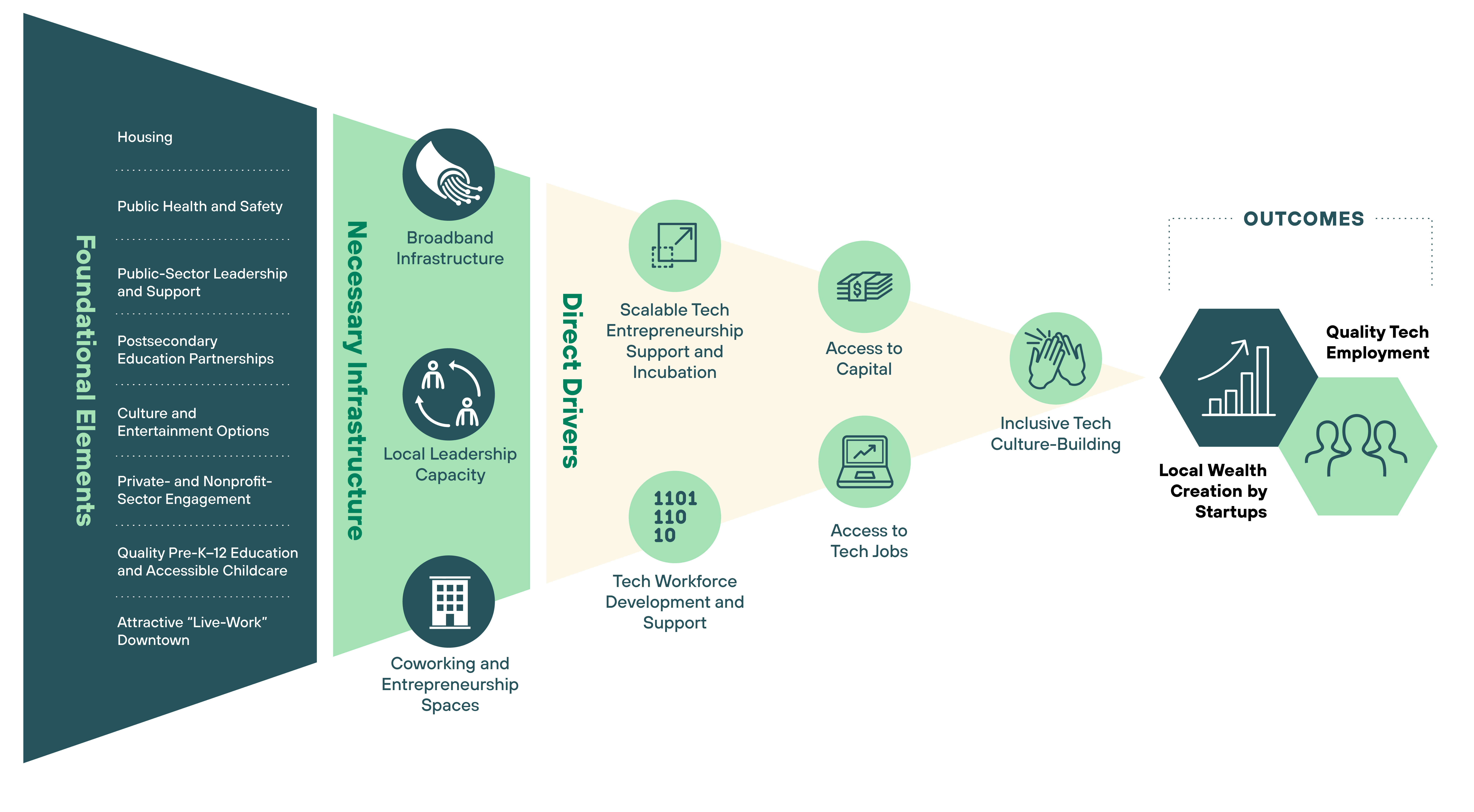Direct driver: Tech workforce development
For a tech economy ecosystem to thrive, it needs tech workers. That means having people trained on the technology skills — from cybersecurity to front end development, data science to UI, and many more.
What are direct drivers of a tech economy?
How does a rural place build a thriving tech economy ecosystem? At the Center on Rural Innovation, answering that question — and helping communities put those answers into practice — is a core part of our mission.
Based on our deep experience in rural economies, on-the-ground work providing technical assistance on tech-based economic development with rural communities across the country, and intensive data analysis, we have identified five direct drivers of rural tech economy ecosystems — the elements that enable communities to successfully compete in the tech economy: scalable tech entrepreneur support and incubation; tech workforce development and support; access to capital; inclusive tech culture building; and access to tech jobs. As part of our work, we help rural communities — who each come to the table with different assets and strengths — develop strategies for implementing each of these drivers.
In this five-part blog series, we dive into each direct driver — defining it, explaining its purpose, highlighting rural communities in our Rural Innovation Network that exemplify doing it well, and offering tips on how other communities can drive their own success.
Direct driver No. 3: Tech workforce development
At the Center On Rural Innovation, we define tech workforce development as a direct driver like this:
Communities need training, education, and skilling programs that provide workers with tech skills that are attractive to employers (e.g., coding, data science). Support services like apprenticeship programs, soft-skills training, and shared work spaces are also important to smooth the transition to tech work, particularly in low-income communities. Success with tech jobs can also have important cultural effects, creating stories that inspire students and other members of the labor force to pursue tech-economy opportunities, and building confidence that inspires more companies to hire in the area.
The need for a tech workforce
It may sound obvious, but it’s no the less true: For a tech economy ecosystem to thrive, it needs tech workers. That means having people trained on the digital and technology skills — from cybersecurity to front end development, data science to UI, and many more — that are increasingly relevant in the modern economy.
Building that tech workforce is a multi-pronged process, and the tech training itself can come in many different forms — from many different kinds of institutions. Nearby higher ed institutions are often a great place to start, since they have — or could develop — computer science and other high-tech courses that equip students with career-ready skills.
No matter what type of training is offered, communities can deepen their impact by offering wrap-around services that are not as commonly found in rural areas.
Tech skilling is unique, however, because of the explosion in online and non-traditional training opportunities. There are many providers, from Udacity to Flatiron to an array of online certifications, that hone in specifically on tech career readiness.
No matter what type of training is offered, communities can deepen their impact by offering wrap-around services that are not as commonly found in rural areas.
One strategy is to employ a cohort model, where community members taking similar tech training programs are paired with each other so they go through the process together, instead of just online alone. Communities can also get creative to address the barriers people have to these programs, including by providing child care, connections to mentors, or equipment.
The benefits of building local tech talent this way from the ground up are immense, in the short- and long-term. Right away, having a tech workforce can bring high-paying jobs to a community. And down the road, having a density of talented tech workers can spur the kinds of collaborations and innovations that sustain entrepreneurship.
Success stories from the Rural Innovation Network
- Cape Girardeau, Missouri: The coworking and innovation space Codefi runs Code Labs One, a 20-week course designed to introduce adults to computer programming. The course pairs participants with local tech employers in a team environment, giving learners real world experience and a better chance of employment. Codefi also starts training young, running the Youth Coding League, an after school program for middle school students using Google’s CS First curriculum.
- Portsmouth, Ohio: Shawnee State University in Portsmouth is ranked No. 9 nationally in Game Design; local ecosystem leaders such as the Kricker Innovation Hub are beginning to tap into this talent pool to keep graduates local and stimulate entrepreneurship.
Strategy tips
- Do an inventory of the local higher ed landscape. Are there institutions offering computer science courses or other training? Do the institutions have entrepreneurship programs, and can they be better integrated into the community’s tech ecosystem? Figuring out what post-secondary options exist can help identify gaps and the most appropriate new kinds of training options to fill them.
- Bring people together who are training on tech skills. Because of how prevalent remote and online options are, many tech skilling participants in rural places will be dispersed and lacking a community of people going through the same journey. By pairing learners in cohorts, giving them access to mentors, and providing platforms to connect them with the local and remote job markets, communities can increase participation and retention in the skilling programs of the future.
- Utilize programs all across the skills ladder. Offering training for more entry-level skills such as IT support along with more advanced skills such as software development make it more accessible for residents to have their needs met and join the tech economy at the level that is best for them.
Conclusion
Tech skills can be learned from anywhere — and they are the core of a community’s tech workforce, which in turn is the core of a tech economy. By utilizing the best of training programs and imbuing them with local supports and connections, communities can grow a more talented workforce that works for and launches the tech companies of their area’s future.
Keep reading
Interested in learning about our other direct drivers? You can read about each of them here:
- Direct driver: Access to capital
- Direct driver: Inclusive tech culture building
- Direct driver: Scalable entrepreneur support and incubation
- Direct driver: Access to tech jobs
To meet the Rural Innovation Network communities doing ecosystem building in small towns across the country, you can find a list here.
If you are a community interested in working with us to grow or build your own digital economy ecosystem, please contact us.

